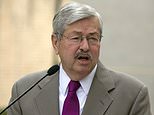April, 2017: Donald Trump welcomes China’s President Xi Jinping for two-day summit at his Mar-a-Lago resort in Florida.
Trump hails the ‘tremendous progress’ made at the meeting and Xi references further understanding and trust between the countries.
In May, US Commerce Secretary Wilbur Ross reveals a ten-part agreement between Beijing and Washington to build up trade.
March, 2018: White House imposes a broadside of tariffs worth $50 billion on Chinese goods coming into the US.
Trump administration claims that China is stealing American tech and intellectual property.
Beijing retaliates in April with its own import taxes on a raft of US products.
The trade war marks a shift from the peaceful overtures of the previous year.
July, 2018: Trade war turns ugly as Trump unleashes fresh tariffs on Chinese goods worth another $34 billion.
China lashes back with its own tariffs on US commodities worth $34 billion.
Trump says that China has been ‘ripping off’ America for years, while the Chinese accuse Washington of ‘trade bullying.’
Resulting impact on trading floors puts the world on edge.
December, 2018: US ally Canada arrests Meng Wanzhou, CEO of Huawei, at Washington’s behest.
Department of Justice claims that Meng breached trade sanctions against Iran, committed fraud and demands extradition.
China detains two Canadian citizens who it alleges threaten its national security.
March, 2019: Huawei sues the US for banning federal agencies for using its technology.
The White House warns other countries against deals with Huawei and using its consumer products.
May, 2019: Trade war is ramped up as US increases tariffs from 10 to 25 percent, worth $200 billion worth of Chinese goods.
China hits back with import taxes worth $60 billion.
Trump believes that he can bring China to heel, while Beijing says he has ‘extravagant expectations.’
White House bans all US companies from using foreign-made telecoms equipment.
November, 2019: Trump signs bill backing the Hong Kong pro-democracy protesters.
January, 2020: Trump and Chinese Vice Premier Liu He sign ‘Phase One’ of a trade deal as the countries finally appear to be putting an end to their two year-long trade war.
Deal eases tariffs and China pledges to buy US goods worth $200 billion and enforce laws to protect US intellectual property.
However, many of the tariffs remain and it fails to tackle Beijing’s colossal subsidies of Chinese companies which American CEOs have long decried for stacking global markets against them.
Trump says these issues can be ironed out in ‘phase two’ of the deal.
Tensions soar amid the coronavirus pandemic as Trump bans travel from China on January 31.
The US accuses China of covering up extent of the pandemic after it was designated as such by the WHO.
A Chinese Foreign Ministry spokesman makes spurious claims that the virus was brought to China by a US soldier.
Trump continues to call it the ‘China virus’ despite the countries agreeing a level of cooperation to deal with the crisis.
March, 2020: China expels US journalists from the New York Times, Wall Street Journal, and Washington Post.
It also demands that other American publications hand over information about their activities in China.
July 14, 2020: Trump ends special trade status for Hong Kong and introduces sanctions for companies on the island which are pro-Beijing.
Beijing furiously responds to US ‘interference’ in its domestic affairs.
July 22, 2020: US orders China to shut its consulate in Houston, Texas, claiming it was used for spying.
China responds by closing American consulate in Chengdu.
